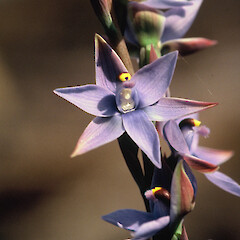Thelymitra malvina
Common name
mauve sun orchid
Synonyms
None
Family
Orchidaceae
Flora category
Vascular – Native
Endemic taxon
No
Endemic genus
No
Endemic family
No
Structural class
Orchids
Chromosome number
2n = 26
Current conservation status
The conservation status of all known New Zealand vascular plant taxa at the rank of species and below were reassessed in 2017 using the New Zealand Threat Classification System (NZTCS) – more information about this can be found on the NZTCS website. This report includes a statistical summary and brief notes on changes since 2012 and replaces all previous NZTCS lists for vascular plants.
Please note, threat classifications are often suggested by authors when publications fall between NZTCS assessment periods – an interim threat classification status has not been assessed by the NZTCS panel.
- Conservation status of New Zealand indigenous vascular plants, 2017 . 2018. Peter J. de Lange, Jeremy R. Rolfe, John W. Barkla, Shannel P. Courtney, Paul D. Champion, Leon R. Perrie, Sarah M. Beadel, Kerry A. Ford, Ilse Breitwieser, Ines Schönberger, Rowan Hindmarsh-Walls, Peter B. Heenan and Kate Ladley. Department of Conservation. Source: NZTCS and licensed by DOC for reuse under the Creative Commons Attribution 4.0 International licence.
2017 | Non-resident Native – Coloniser | Qualifiers: EF, SO
Previous conservation statuses
2012 | Non-resident Native – Coloniser | Qualifiers: EF, SO
2009 | Non-resident Native – Coloniser | Qualifiers: SO
2004 | Non-resident Native – Coloniser
Distribution
Indigenous. New Zealand: North Island (known locally from the North Cape area, Ahipara Gumfields, Kaimaumau and Lake Ohia wetlands near Kaitaia and from Ngawha Springs near Kaikohe). Also Australia (common in New South Wales, Victoria, Tasmania and South Australia).
Habitat
Open ground within peat bogs and wetlands, nearly always found in association with rotting kauri (Agathis australis (D.Don) Lindl.) logs.
Wetland plant indicator status rating
Information derived from the revised national wetland plant list prepared to assist councils in delineating and monitoring wetlands (Clarkson et al., 2021 Manaaki Whenua – Landcare Research Contract Report LC3975 for Hawke’s Bay Regional Council). The national plant list categorises plants by the extent to which they are found in wetlands and not ‘drylands’. The indicator status ratings are OBL (obligate wetland), FACW (facultative wetland), FAC (facultative), FACU (facultative upland), and UPL (obligate upland). If you have suggestions for the Wetland Indicator Status Rating, please contact: [Enable JavaScript to view protected content]
FACW: Facultative Wetland
Usually is a hydrophyte but occasionally found in uplands (non-wetlands).
Detailed description
Glabrous, terrestrial orchid. Tubers ovoid 10–30 × 5–12 mm, fleshy, pinkish-grey. Leaf linear to linear-lanceolate, 100–350 × 5–20 mm, light to dark green with a purple base, erect, canaliculate, fleshy, abaxial surface ribbed, sheathing at base, apex acute. Inflorescence 0.25–0.75–(0.9) m tall, 1.5–5.0 mm diameter, stout, fleshy, straight, green to purple-green. Sterile bracts (2)–3, linear to linear-lanceolate, 20–100 × 4–11 mm, closely sheathing, acute to acuminate, green or purple-green, upper bract usually free with base usually only half encircling the scape. Fertile bracts 8–30 × 3–6 mm, green or purple-green, ovate-acuminate to obovate-acuminate, sheathing the pedicels. Pedicels 5–15 mm long, slender. Ovary cylindrical to narrow-obovoid, 5–12 × 2–4 mm. Flowers 3–25, 18–32 mm diameter, slate blue to mauve inside, sepals greenish outside, opening readily in warm weather. Perianth segments 8–16 × 3–7 mm, concave, acute, shortly apiculate; dorsal sepal elliptic to lanceolate; lateral sepals elliptic to lanceolate, asymmetric; petals ovate to lanceolate; labellum elliptic to linear-lanceolate, often narrower than other segments. Column erect, 6–7.5 × 2.5–3.7 mm, mauve; post-anther lobe cucullate, 2–4 × 1.5–2.5 mm, tubular, inflated, compressed dorsally, curved gently, dark reddish brown, apex shallowly bilobed, lobes toothed, orifice small, yellow; post-anther lobe extension 0.6–0.2 mm; auxiliary lobes absent; lateral lobes converging 1–1.5 mm long, digitiform, obliquely erect, each with a more or less terminal, dense, broom of mauve or pink cilia 1–1.5 mm long. Anther inserted near middle of column, ovoid, 2.5–3.5 × 1.2–2.2 mm, the connective prolonged into a 0.5–1.0 mm long beak. Stigma at base of column, 1.8–2.6 × 1.5–2.5 mm, ovate-quadrate. Capsules 12–20 × 4–6 mm, obovoid, erect, ribbed.
Manaaki Whenua Online Interactive Key
Similar taxa
Thelymitra malvina has no close relatives in New Zealand. The tall stout but slender scape and mauve to slate blue flowers with mauve to pink mop-like cilia tufts on the lateral lobes are very distinctive. In New Zealand, Thelymitra malvina usually has > 5 flowers per scape and these characteristically all open at the same time. Its nearest relative is the Australian endemic T. atronitida Jeanes from which it differs by the usually three rather than two sterile bracts, larger mostly insect-pollinated rather than autogamous flowers, dark reddish brown rather than glossy black post anther lobes, and mauve or pink rather than white lateral lobe cilia.
Flowering
(September)–October–(November)
Flower colours
Blue, Violet/Purple
Fruiting
October–January
Propagation technique
Not in cultivation. A strongly mycorrhizal species which should not be removed from the wild
Threats
Plant collectors are a constant problem because it is a conspicuous orchid with very attractive flowers. It is threatened at many sites by invasive weeds, changes to the local water table, and removal of swamp kauri logs for furniture making. However, it is also reasonably secure at several sites and indications are that it actively spreading in suitable habitats throughout Northland
Etymology
thelymitra: Woman’s hat
Where To Buy
Not commercially available
Attribution
Fact Sheet prepared for NZPCN by P.J. de Lange 14 April 2007. Description subsequently published in Rolfe & de Lange (2010). See also Jeanes (2004).
References and further reading
Jeanes J. 2004. A revision of the Thelymitra pauciflora R.Br. (Orchidaceae) complex in Australia. Muelleria 19: 19–79. https://www.biodiversitylibrary.org/page/59426325#page/21/mode/1up.
Rolfe JR, de Lange PJ. 2010. Illustrated guide to New Zealand sun orchids, Thelymitra (Orchidaceae). Jeremy Rolfe, Wellington, NZ. 57 p.
NZPCN Fact Sheet citation
Please cite as: de Lange, P.J. (Year at time of access): Thelymitra malvina Fact Sheet (content continuously updated). New Zealand Plant Conservation Network. https://www.nzpcn.org.nz/flora/species/thelymitra-malvina/ (Date website was queried)















